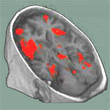Tuesday, 6 August 2013
“Centres” of Cognitive Functions in the Brain: A Misleading Concept

The media nowadays often publish reports that scientists using brain-imaging technology have just discovered the brain’s “centre” for anger, jealousy, generosity, or some other specific emotion or cognitive function. But the idea of such a centre is, at best, an outrageous oversimplification, and at worst, completely misleading.
That is the argument made by Dr. William A. Cunningham in the February 2012 issue of the journal Current Directions in Psychological Science. His article deconstructs a very limited view of a part of the brain called the amygdala,which the popular press often describes as the brain’s “fear centre”.
There is no question that when somebody is afraid of something, their amygdala becomes highly active. But as Dr. Cunningham notes, numerous brain-imaging experiments have shown that this is far from the only situation in which the amygdala “lights up”. By analyzing numerous studies of the amygdala, Cunningham has found that the actual role of this brain structure is far more subtle. In reality, it seems to become active in conjunction with any “event that may be of immediate concern to a person”. A situation that arouses fear, such as finding yourself face-to-face with a bear, is certainly an event of immediate concern. But so is seeing a picture of food, for a person who is hungry, or seeing a picture of other people in distress, for a person who is highly empathetic. And in fact studies show that the amygdala also becomes very active in precisely such situations.
One reason that the amygdala can become active in such very different situations is that it never really acts alone. The brain comprises a vast network of richly interconnected structures, and for someone to experience the slightest emotion or perform the smallest cognitive task, it is never just one area of the brain that must be activated, but rather several. The number of areas seen to be activated may be two, five, 10, 12, or more, depending on the task or emotion involved, the accuracy of the instruments used to detect their activation, and even the methodology used for this purpose (see the third and fourth links below). A particular brain structure such as the amygdala can thus be part of various functional networks, the activation of any one of which, distributed throughout the brain, may be associated with a particular task or emotion.
Instead of trying to simplistically label a brain “centre” that is supposedly responsible for such a task or emotion, we would do better to consider the network involved, as a whole. Perhaps one day, scientists will in fact identify a specific function for a particular brain structure. But that function may not necessarily be describable in catchy terms for the mass media. You have to admit that if you’re trying to sell newspapers, calling the amygdala “a structure that becomes active in response to an event that is of immediate concern to a person” is far less sexy than calling it “the brain’s fear centre”.
![]() Why Brain Imaging Studies Can Be Misleading
Why Brain Imaging Studies Can Be Misleading
![]() THE AMYGDALA AND FEAR ARE NOT THE SAME THING
THE AMYGDALA AND FEAR ARE NOT THE SAME THING
![]() New Approach Increases the Usefulness of Brain Scans
New Approach Increases the Usefulness of Brain Scans
![]() Decoding subject-driven cognitive states with whole-brain connectivity patterns
Decoding subject-driven cognitive states with whole-brain connectivity patterns
Emotions and the Brain | Comments Closed







